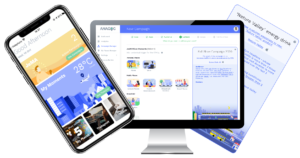Believe It or Not, Pokemon Go Can Be an Even More ‘Powerful’ Creature
Pokemon Go is an app that needs little introduction. It’s already taken the entire world by storm. Millions of users across the globe are pulling their iPhones/Androids out their pockets on a daily basis to hunt, capture and battle the creatures, in a game that blends the real world with a virtual one. Created by Nintendo through GPS-location based and Augmented Reality (AR) technology, Pokemon Go is free to play, but is set to make a dizzying amount of money from in-app purchases over the coming months, with user numbers predicted to topple that of Twitter.
It’s all about the sensors
Pokemon Go uses several sensors for the AR mode; the camera, the compass the gyroscope, as well as the GPS and accelerometer. The game integrates your current location with the in-game map. As you walk, the app uses your phone’s camera to place an image of a Pokemon within your surroundings and uses the compass and gyroscope to track the phone’s rotation and direction in order to give the game an idea of where your phone is pointing.
In addition, Pokemon Go uses your phone’s clock to track the time, and also takes climate, vegetation, and soil or rock into account, so that Grass-type Pokemon pop up in scrubland areas, and Water-type Pokemon appear by water.
But what if it was even more contextual and personal?
Like most apps that work with the GPS in your smartphone, Pokemon Go can tell a lot of things about you based on your movement as you play; where you go, when you went there and how long you stayed. But what if Pokemon Go had also the user’s mobility status detection integrated?
What if it could detect how you are moving (car, bus, train, plane), if you are asleep or awake, or if you are walking alone or as part of a group? What if it had a smart location-based services and mobility status SDK integrated into the app’s code? Just imagine the possibilities that would open up for users, in what is already an enormously involving game.
Here are a few examples:
Imagine that Pokemon Go would be able to identify that you are currently in a crowded party, with more players around you. It could turn the game into a competition with the surrounded players, or offer you to catch some drunk Pokemons that are dancing around. If Pokemon Go will be able to tell that you are currently on the bus or a train, most likely looking to kill some time, it can offer a richer play mode specifically at that time. This is very likely to increase engagement and lengthen playing time.
Getting more serious, mobility status integrated into apps can also help avoid some dangerous scenarios, and potentially disable the game should they know a user is currently driving a car for example.
Yes, Nintendo is taking care of proper warnings on the game’s website:
“For safety’s sake, never play Pokemon GO when you’re on your bike, driving a car, riding a hoverboard, or anything else where you should be paying attention, and of course never wander away from your parents or your group to catch a Pokemon.”
But what if they actually had this information in real time and can post the right warnings at the right time, live, on-screen? Much more effective indeed!
Getting Personal is Easy You Think?
Obviously, every app and game is trying to achieve higher engagement and retention levels of their users. The more personalized and contextual apps are, the higher their user engagement tends to be.
We all agree by now that by understanding users’ real-world movements and preferences through analysis of existing multiple sensors in smartphones, Pokemon Go and apps, in general, could be a lot more personal.
Saying every app/game could benefit from intelligent location-based services is one thing – but is it that easy to achieve?
Apparently, this is still quite challenging to achieve due to issues around battery drain, data quality, and data accuracy. If you want to try out the Anagog’s JedAI SDK to get a first-hand impression of how we solved these issues in our JedAI SDK, making the integration of mobility status a breeze for app developers, you can download our JedAI SDK here.
Pokemon Go has proved enormously popular in the current climate where users are hungry for a personalized app experience. It’s amazing to think what this app – or any other location-based game or utility app – could achieve with more contextual services, powered by real-time mobility status information. This is no doubt a start of something big and exciting!
Ofer is the CEO at Anagog. With 20 years’ experience as entrepreneur and leader of High Tech private and public companies, Ofer leverages his technology and management experience to drive Anagog’s long term success. Prior to Anagog Ofer served as the CEO of OTI, a leading developer of NFC based payment solutions and as the CEO of Parx, a provider of on-street parking payment solutions. In 2000 Ofer co-founded LocatioNet Systems, a pioneer in the Location-Based Services market. In 2001 the World Economic Forum awarded him in Davos as ‘Technology Pioneer’. Ofer has an LLB Law degree from the Tel-Aviv University.



